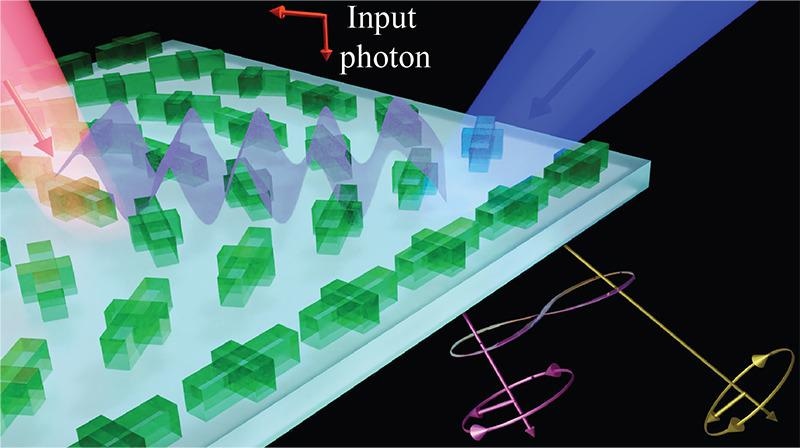A research group from Los Alamos National Laboratory has suggested that modulated quantum metasurfaces have the ability to regulate all properties of photonic qubits, a discovery that could influence the fields of quantum information, sensing and imaging, communications, as well as momentum and energy harvesting.
 A metasurface with all-optical modulation of the refractive index induces color-spin-path quantum entanglement on a transmitted single photon. Image Credit: Los Alamos National Laboratory.
A metasurface with all-optical modulation of the refractive index induces color-spin-path quantum entanglement on a transmitted single photon. Image Credit: Los Alamos National Laboratory.
The study results were published recently in the Physical Review Letters journal by the American Physical Society.
People have studied classical metasurfaces for a long time. But we came up with this new idea, which was to modulate in time and space the optical properties of a quantum metasurface that allow us to manipulate, on-demand, all degrees of freedom of a single photon, which is the most elementary unit of light.
Diego Dalvit, Condensed Matter and Complex Systems Group, Theoretical Division, Los Alamos National Laboratory
Metasurfaces are ultrathin structures with the ability to control light in ways not generally observed in nature. In such a case, the researchers designed a metasurface that appeared similar to a range of rotated crosses, which they can then control with lasers or electrical pulses.
The researchers suggested shooting a single photon via the metasurface, where the photon divides into a superposition of several paths, colors and spinning states that are all intertwined, thereby producing purported quantum entanglement — implying that the single photon can inherit all these different properties directly.
When the metasurface is modulated with laser or electrical pulses, one can control the frequency of the refracted single photon, alter its angle of trajectory, the direction of its electric field, as well as its twist.
Abul Azad, Center for Integrated Nanotechnologies at Materials Physics and Applications Division, Los Alamos National Laboratory
By controlling such properties, this technology could be utilized to encode data in photons traveling inside a quantum network, everything right from quantum computers, banks and between Earth and satellites.
Encoding photons is especially suitable in the field of cryptography since “eavesdroppers” are not capable of viewing a photon without altering its basic physics, which if performed would further alert the sender and receiver that the data has been compromised.
Moreover, the researchers are working on how to draw photons from a vacuum by altering the quantum metasurface.
The quantum vacuum is not empty but full of fleeting virtual photons. With the modulated quantum metasurface one is able to efficiently extract and convert virtual photons into real photon pairs.
Wilton Kort-Kamp, Theoretical Division at Condensed Matter and Complex Systems Group, Los Alamos National Laboratory
Exploiting photons that are present in the vacuum and shooting them in a single direction must help create propulsion in the opposite direction. In the same way, vacuum stirring should make a rotational motion from the twisted photons. Furthermore, structured quantum light could someday be utilized to produce mechanical thrust, utilizing only small amounts of energy to push the metasurface.
The study was financially supported by Defense Advanced Research Projects Agency (DARPA) and Los Alamos National Laboratory Directed Research and Development (LDRD).
Journal Reference:
Kort-Kamp, W. J. M., et al. (2021) Space-Time Quantum Metasurfaces. Physical Review Letters. doi.org/10.1103/PhysRevLett.127.043603.